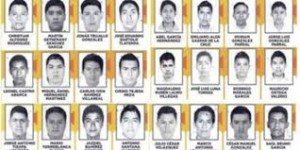 Note: This Fact Sheet, prepared by the CIP Americas Program, was delivered at a Congressional Briefing hosted by the office of Representative Hank Johnson (D-Georgia) on October 29 and co-sponsored by the Center for Economic and Policy Research, the Guatemala Human Rights Commission, Just Associates, CISPES and CIP-Americas. The video, by CEPR, can be viewed here (original Spanish not translated).
Note: This Fact Sheet, prepared by the CIP Americas Program, was delivered at a Congressional Briefing hosted by the office of Representative Hank Johnson (D-Georgia) on October 29 and co-sponsored by the Center for Economic and Policy Research, the Guatemala Human Rights Commission, Just Associates, CISPES and CIP-Americas. The video, by CEPR, can be viewed here (original Spanish not translated).
Mexico in Crisis: U.S. Drug War Funding, Ayotzinpapa and Human Rights Violations
On Sept. 26, Iguala police opened fire on students from the rural teachers’ college of Ayotzinapa, followed by more attacks throughout the night. Six persons were killed and 43 students are missing. The Ayotzinapa disappearances have triggered massive protests throughout the country.
Mexico is facing its worst political crisis in decades. U.S. policy has contributed to the crisis by funding corrupt security forces responsible for crimes against their own population.
- The vast majority of U.S. aid to Mexico is focused on fighting the war on drugs. This aid comes primarily through two channels: the Merida Initiative (MI) administered by the State Department and Department of Defense counternarcotics funds. The Merida Initiative, launched as a three-year plan by the Bush Administration in 2007 and funded in 2008, supports Mexican security forces, primarily in counternarcotics efforts to dismantle drug cartels. The Obama administration extended the MI “indefinitely”.
The Merida Initiative has already cost taxpayers $2.4 billion dollars. The Department of Defense has spent $214.7 million on the Mexican drug war just since 2011, when figures are available. Additional public funds for Mexico’s drug war come through the Department of Justice for extensive Drug Enforcement Administration (DEA) and Alcohol, Tobacco and Firearms (ATF) operations in Mexico. This means that:
The U.S. government has spent approximately $3 billion dollars on the war on drugs in Mexico alone.
What are the results?
* 100,000 murdered in drug war-related violence
* More than 25,000 disappeared, tens of thousands forced to flee their homes, thousands of orphans and incalculable psychological trauma
* Mass graves in Guerrero, Tamaulipas, Chihuahua and other states with unidentified bodies
* Rise in violations of the rights and physical safety of transmigrants in the country
* Rise in violations of the rights of women and sexual crimes, including femicides
* Increase in torture and extrajudicial executions
Mexican security forces routinely violate human rights and murder youth: Two Cases–Tlatlaya, Mexico State and Ayotzinapa, Guerrero
- AYOTZINAPA: 6 DEAD AND 43 STUDENTS MISSING IN ATTACK BY POLICE
On September 27, three busloads of students from the Rural Teachers’ College were stopped by local police of Iguala, who opened fire on the students without warning. Hours later, an armed commando shot at the unprotected group of students and there was also an attack on a youth soccer team and taxi on the road nearby. Three students and three other people are dead, and another student is reported brain dead after being shot in the head. Eyewitnesses show police taking the missing students into custody. Testimony from members of the criminal gang Guerreros Unidos picked up by police and video footage indicates that the local police delivered the students to the organized crime group, which says they killed them. The students have not been found, dead or alive, and their families’ still hope for the best but are frustrated by the government’s lack of response and results
Youth, educators, human rights activists and citizens are protesting throughout the nation. They call this a “crime of the state”. Although it is clear that organized crime controlled the Iguala mayor, much of his government and the local police force, the state and federal government’s knowledge of the situation and failure to respond have led to the governor’s resignation under pressure and widespread calls for the president to step down. The search for the students has revealed more than ten clandestine mass graves containing unidentified bodies in the area.
- TLATLAYA, ARMY ACCUSED OF EXTRAJUDICIAL EXECUTIONS IN DEATH OF 22 YOUTH
On June 30, the 102 Battalion of the Mexican Army confronted an alleged delinquent gang in San Pedro Limon, municipality of Tlatlaya, Mexico State, leaving 22 young people dead and no casualties on the side of the army. This sparked the interest of the press, which began to investigate the case. Later, local witnesses came forth who stated that the army executed the majority of the youth after they gave themselves up. Witnesses say 21 were executed, while the National Commission on Human Rights recognizes 15 victims with clear signs of execution. The crime scene was altered to reinforce the pretext of an armed confrontation. The unit was under the command of Lt. Ezequiel Rodríguez Martínez.
General José Luis Sánchez León, commander of the 22nd Military Zone responsible for Tlatlaya, was subsequently removed from his post without explanation. One officer and seven soldiers are under arrest and currently being investigated. A Mexican Congressional Committee has been formed to investigate. The State Department confirms that 5 members of the 102nd Battalion were trained by U.S. agencies, but neither government has released names to indicate whether those trained in the U.S. are directly implicated in the killings.
These cases are the most recent and among the most egregious cases of crimes by Mexican security forces, but they are not the only ones. U.S. aid to these forces, far from improving the situation is increasing abuses. It should be halted immediately.
Resources:
Comisión Nacional de Derechos Humanos, SOBRE LOS HECHOS OCURRIDOS EL 30 DE JUNIO DE 2014 EN CUADRILLA NUEVA, COMUNIDAD SAN PEDRO LIMÓN, MUNICIPIO DE TLATLAYA, ESTADO DE MÉXICO Oct. 21, 2014
http://www.cndh.org.mx/sites/all/fuentes/documentos/Recomendaciones/2014/REC_2014_051.pdf



